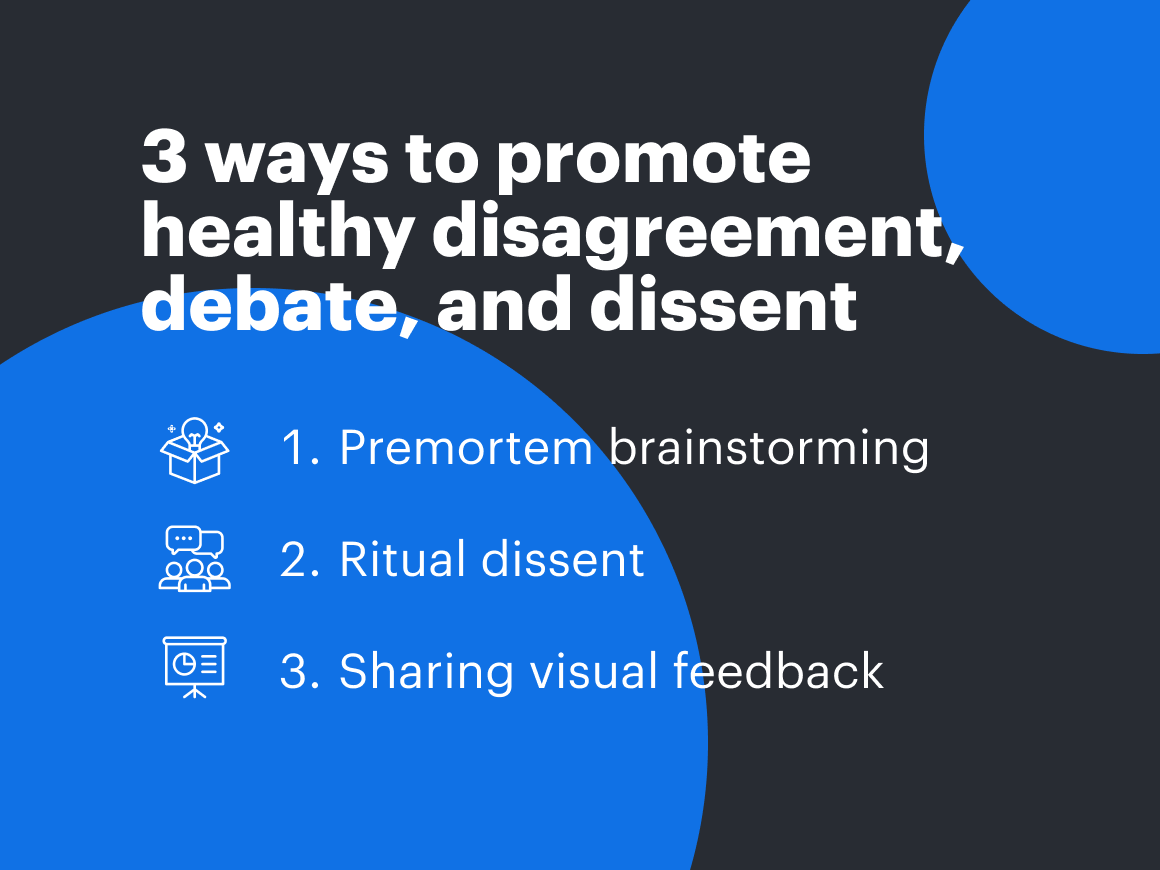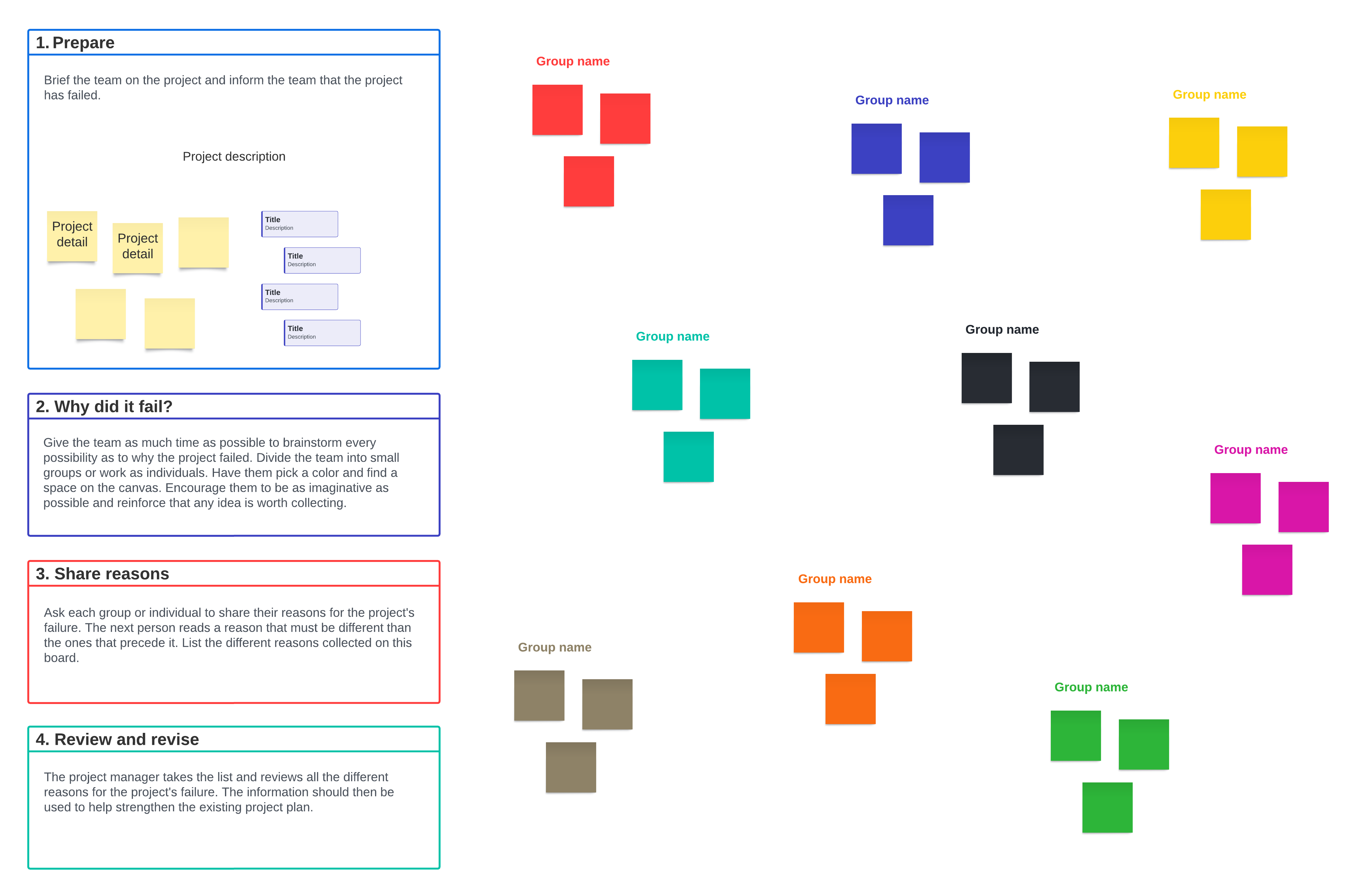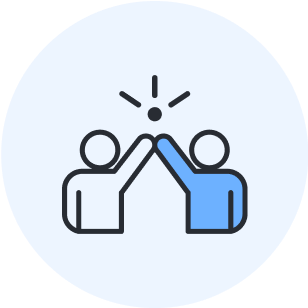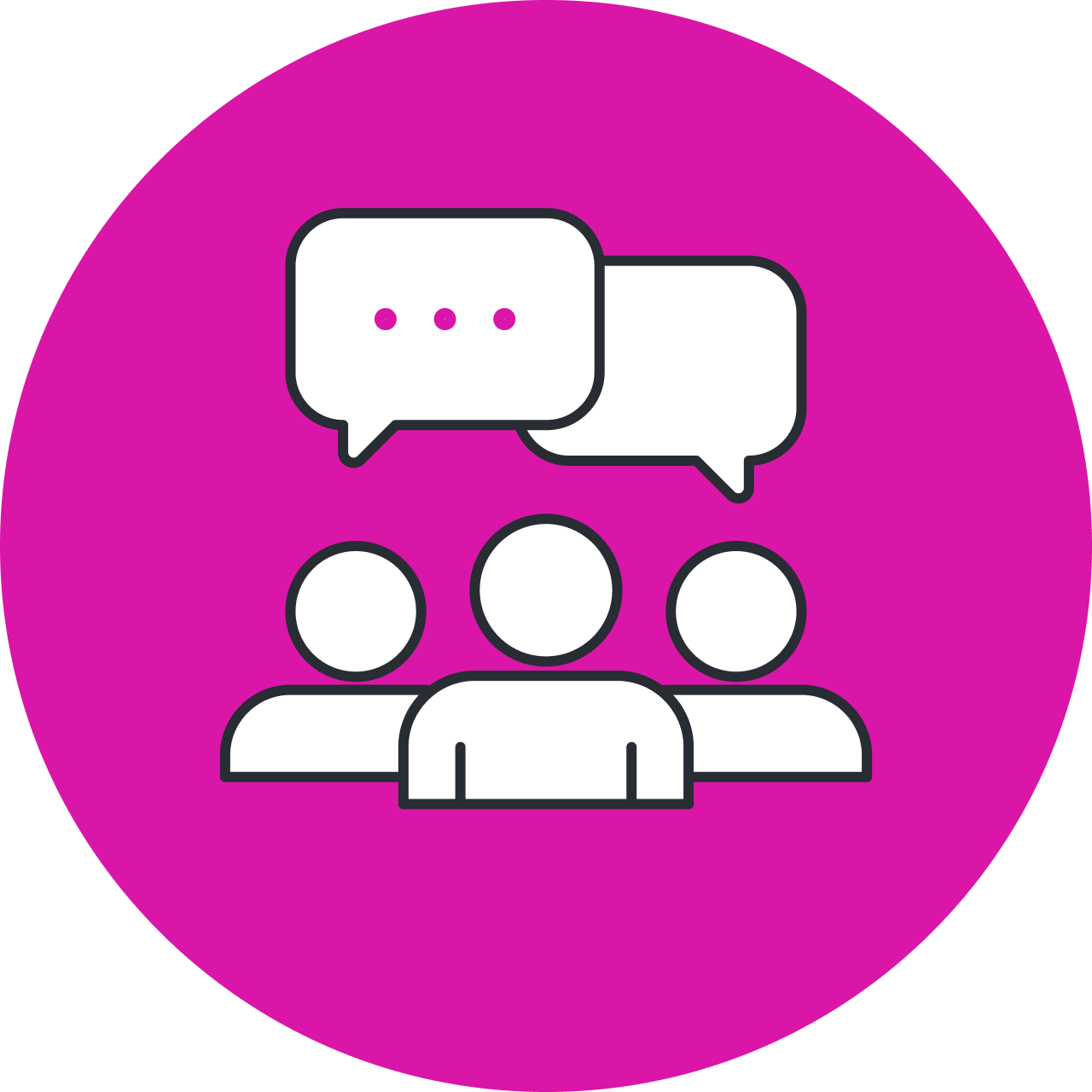
How to embrace contributory dissent during collaboration
Reading time: about 10 min
Topics:
Disagreement and dissent are a natural part of bringing diverse opinions together to generate new ideas, vet and validate outside-the-box strategic and creative approaches, and ultimately enable innovation in both product and business.
Contributory dissent—that is, intentional, divergent discussions about important business issues—is a healthy way for teammates to express their differences.
In fact, embracing conflict can help build meaningful relationships. Facilitating productive, positive discussions between dissenting (opposing) groups is a particularly important aspect to improving psychological safety at work.
So why are we still so afraid of disagreement and dissent in the workplace?
Building a healthy relationship with disagreement and contributory dissent
Disagreement and dissent have become particularly difficult as teams have moved to hybrid and fully remote working environments. Human language is often imprecise, and relying on verbal communication alone can create misunderstandings or hurt feelings when colleagues share alternate points of view—especially if we haven’t fully built trust and psychological safety with those we are collaborating with yet.
When teams aren’t able to disagree in collaborative settings, they might default to gossip as a way of getting their opinions out. But when we stew in negativity privately, we never give our alternate, diverse, and novel ideas a chance to thrive in the light of group debate or discussion.
Left unchecked, a company culture that doesn’t support healthy disagreement is ultimately undermining its own ability to be innovative and competitive.
3 tools for encouraging disagreement and contributory dissent
To truly innovate, teams need to focus on achieving true alignment, not just surface-level agreement. And true alignment can only come after going through the process of debate, evaluation, and yes, even disagreement and dissent.
When you embrace debate and contributory dissent and attack your own ideas thoughtfully with a structured framework, you can disincentivize backchannel chat and gossip after meetings and avoid the “comfortable consensus” that comes with groupthink.
Here are three techniques you can use to incentivize and embrace healthy debate within your team to reduce hesitancy around disagreement.

1. Premortem brainstorming
One of the biggest areas where disagreement and dissent can benefit businesses is in the process of challenging assumptions.
Institutional knowledge, learned best practices, and deep industry expertise are all valuable assets to have as an individual and group—they allow us to make assumptions on intuition that can often prove correct. But when you’re navigating truly uncharted territory, defaulting to “the way we’ve always done it” can create dangerous blind spots as you approach risks, roadblocks, and competitive opposition you’ve never seen before.
When you’re starting on a new initiative or project that requires novel thinking, you’ll need to challenge your assumptions early and often to give your work the greatest chance of success. You don’t, however, want members of your team to endlessly play devil’s advocate for its own sake, which might stroke egos but ultimately slow down progress.
So, how can you challenge your own assumptions and the status quo at large, while still maintaining productivity? The key is hosting a premortem brainstorm.

A postmortem is an open discussion of what caused a project to fail, and what the team should do differently next time. A premortem flips the idea of a postmortem on its head. It gives teams the space to ideate and debate what might cause a future project to fail and what can be done proactively to strengthen the most likely points of failure so that the project has a stronger chance of success, hopefully saving you time and money in the long run.
Premortems provide a way to discuss inherently thorny topics (like failure, business vulnerabilities, product and skills gaps, competitive deficiencies, and more) in a structured way. The ultimate goal of a premortem is project success, not the airing of grievances—which helps reduce the likelihood of people speaking out in frustration. These discussions encourage valuable, honest critiques of the business’s weaknesses as a whole.
Here are some tips to keep in mind as you host your own premortems:
- Premortems are most valuable when the stakes are high and outright failure would be crippling to your business because it allow your team to get a little paranoid (in a positive way!) for the good of your business. If your high-level strategy discussions are normally open-ended, and you’re feeling like your plans are too presumptive of easy success, try inserting a premortem framework to encourage debate.
- If the idea of doing a premortem feels intimidating or overly negative, lean in! You can also start the meeting with an icebreaker activity to ease any tension around discussing the possibility of failure, creating a safe space for teammates to engage.
-
To further cultivate a safe environment, use private mode in Lucid to allow people to contribute their feedback and ideas anonymously. With private mode, you can hide the names of contributors on sticky notes before and after the meeting so people can be honest without fear of judgment or retribution. This practice can lead to more transparent and innovative discussions.
- Premortems are an exercise in looking to the future, but the input that participants give is a reflection of the current state of your business. It’s important to embrace feedback. Don't take it personally or defensively when another colleague mentions a concern that might fall under your domain; instead, view it as an opportunity to learn from new perspectives by understanding why someone views something as a vulnerability.
2. Ritual dissent workshops
When discussing new ideas, if the person who is sharing an idea isn’t finished before experiencing pushback, disagreement, or questioning, this can have a chilling effect on further ideation. That person may be discouraged from sharing more ideas in the future, reducing their willingness to collaborate.
And most people don’t want to hurt their teammates’ feelings either! Much of what makes private, backchannel disagreement so enticing is that we never have to express disagreement to the face of the person who just shared an idea. Without formal structures in place for disagreement, it can be easy for feedback to go unheard or be taken personally. But when feedback is never shared, businesses can’t grow or improve.

Ritual dissent is a framework that seeks to solve this problem by formally separating the processes for sharing ideas and critiquing ideas, allowing a group to consolidate all of their feedback and disagreement together before sharing it with the person who had the idea initially. This framework also eliminates perceived “pile ons” of critical feedback.
A ritual dissent workshop has distinct steps and rules that, when completed in order, allow teams to tackle potentially blunt, frank feedback in a safe and productive way. Here’s how to conduct a ritual dissent workshop:
- In small groups, teammates work together on a proposal or idea that they want feedback on. With breakout boards in Lucid, it’s easy to break a larger group into smaller ones, especially if you’re facilitating a virtual ritual dissent workshop.
- Each group will then appoint a messenger who will present their idea to another group for feedback. With the exception of clarifying questions, the group receiving their presentation holds any feedback until after the presentation is done.
- The messenger then turns their chair to the feedback group and sits with their back to them. (If you are doing this workshop virtually, the messenger should essentially make sure they can hear but not see the video of the group giving feedback.)
- The group then gives their feedback, which should be honest in pointing out flaws, issues, and observed problems with the proposal. Because the messenger can not share non-verbal body language reactions to the feedback, members of the group sharing the feedback are more incentivized to be as honest as possible.
- During the feedback sharing session, the messenger actively listens and takes notes, but does not speak or respond to feedback.
- Once the group is finished giving feedback, the messenger returns to their original group to share what they have heard and work on an improved proposal. Once the proposal has been improved, the messenger goes back to the feedback group, and the process starts again, up to three or four times.
- For the final cycle, have the feedback group switch from giving the messenger dissenting opinions to giving them assenting opinions (i.e., sharing what they like about the proposal) to end the activity on a positive note.
Approaching disagreement through a ritual dissent workshop allows groups to generate higher-quality feedback to rapidly improve the quality of their ideas. This framework also helps to overcome power imbalances and differences in feedback styles that often derail teams from sharing disagreement, and teaches team members to listen more intently.

Focus your team on high-value collaboration
Learn how to engage in high-value collaboration that embraces conflict.
Read more3. Visual Activities in Lucid
Simple differences in collaboration styles can create roadblocks to sharing feedback.
For example, you might prefer to gather your thoughts in writing before sharing them with a group, but if your team primarily shares feedback off the cuff during live meetings, you might feel left out even though you have ideas you want to share. When teams act on the assumption that everyone has provided their thoughts, problems can arise—and can neutralize the impact of hiring a diverse group of people when that diversity of thought isn’t fully unleashed.
Lucid’s Visual Activities capability was designed to achieve real consensus from people who might otherwise silence their opinion for fear of being the black sheep of a group. It allows people to give feedback, input, and disagreement through simple visual inputs instead of relying on verbal communication only.
Visual Activities also allows teams to turn qualitative feedback into actionable insights by turning responses from team members into graphs, charts, and comparative boards that show where a team’s preferences and priorities fall.
You can use Visual Activities to unlock feedback (and dissent) around overall strategic direction, current sprint priorities, product messaging, design mockups, and more. Here are three Visual Activity templates to try in your next meeting:
- Impact + effort matrix: Your team might disagree on how simple or expensive a given project would be to execute. This template helps to start a conversation by letting team members drag proposals to different points on a two-axis graph based on how much impact the proposal would have relative to its effort to produce.
- Urgency + importance matrix: Similar to impact + effort, the urgency + importance matrix asks teams to give feedback on what projects should be done immediately, scheduled for later, delegated to someone else, or eliminated altogether.
- Confidence levels: Quickly see where teammates fall in their confidence on the success of certain initiatives, goals, or approaches, and kick-start a conversation as to why they might feel that way.
Pro tip: You can also use Lucid’s voting and reaction features to make disagreement a democratic process!

Use Visual Activities to improve your team's decision-making velocity.
Give it a tryVisual collaboration enables true alignment
As you work toward achieving positive results and growing your business, it’s important to remember that disagreement is not your enemy—misalignment is.
By engaging in visual collaboration in Lucid and employing proven frameworks for facilitating dissenting opinions, you can overcome barriers such as imprecise language, misunderstandings, and defensiveness—ultimately helping your business embrace feedback and innovate faster.

Learn more about how to use visual collaboration in Lucid to make better strategic decisions faster.
Get our guide.About Lucid
Lucid Software is a pioneer and leader in visual collaboration dedicated to helping teams build the future. With its products—Lucidchart, Lucidspark, and Lucidscale—teams are supported from ideation to execution and are empowered to align around a shared vision, clarify complexity, and collaborate visually, no matter where they are. Lucid is proud to serve top businesses around the world, including customers such as Google, GE, and NBC Universal, and 99% of the Fortune 500. Lucid partners with industry leaders, including Google, Atlassian, and Microsoft. Since its founding, Lucid has received numerous awards for its products, business, and workplace culture. For more information, visit lucid.co.
Related articles
Consensus-building techniques to promote efficient, inclusive decision-making on your team
Get tips and techniques to help your team achieve efficient, inclusive consensus.
